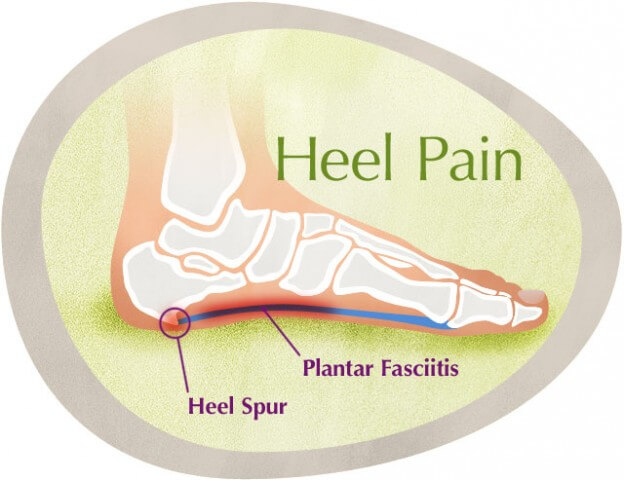
If you are experiencing heel pain, you are not alone.
The heel is a padded cushion of fatty tissue around the heel bone (the calcaneus) that holds its shape despite the pressure of body weight and movement. It serves to protect the structures of the foot, including the calcaneus, muscles and ligaments. Heel pain is a very common foot complaint.
Whether your pain is severe, chronic, dull, or aching, the goal is the same: relief and healing. However, choosing the correct treatment for your heel pain requires carefully evaluating your symptoms and understanding the likely cause.
Causes of Heel Pain : Some of the many causes of heel pain can include:
- Abnormal walking style (gait), such as rolling the feet inwards
- Obesity
- Ill-fitting shoes
- Standing, running or jumping on hard surfaces
- Injury to the heel, such as stress fractures
- Bursitis (inflammation of a bursa – bursae are small sacs that contain fluid to lubricate moving parts, such as joints and muscles)
- Neuroma (nerve enlargement)
- Certain disorders, including diabetes and arthritis.
Complications of heel pain can include :
- Plantar fasciitis : The plantar fascia is a band of connective tissue that runs along the sole from the heel to the ball of the foot. One of its main roles is to keep the bones and joints in position. Bruising or overstretching this ligament can cause inflammation and heel pain. A common cause is flat feet, because the ligament is forced to overstretch as the foot spreads out and the arch flattens. The pain may be worse first thing in the morning or after rest. In many cases, plantar fasciitis is associated with heel spur. The plantar fascia tears and bleeds at the heel and, over time, these injuries calcify and form a bony growth.
- Heel spur : An abnormal walking style, such as rolling the feet inwards, can place extra strain on the plantar fascia. Chronic inflammation may develop and, over time, lead to a bony growth or spur. The spur can only be seen on x-ray, but its presence is often flagged by a tender patch at the heel on the sole of the foot.
You may have heel spurs without realising it - it is estimated that about one in 10 Australians have heel spurs without any symptoms. The spur itself does not cause the pain, but pain may be associated with inflammation in the area.
Ayurvedic View, Causes and Treatment :
This condition is known as Vatakantaka or Padakantaka in Ayurveda- kantaka refers to thorn. The pricking pain felt due to vitiated vata is termed as vata kantaka. Vata kantaka is a very common disease especially in old age as vata rogas/diseases occurs particularly in this time.
Causes according to Ayurveda :
- Standing or walking for long
- Walking in irregular or uneven surface
- Any structural deformity of foot causing increased pressure on heels
- Excessive strain on heels
- Usage of hard foot wears or shoes
- Excess use of hot and spice food
- Age-old age time of vata vitiation.
- Lack of sleep
- Mental stress- lead to vata increase
- Lack of exercise.
- Excess use of sweet and oily food- lead to over weight.
- Obesity
- Diabetics-is one of the kapha vikara/disease
Pathophysiology according to Ayurveda :
According to Ayurveda this condition occurs due to kapha dosha vitiation along with vata dosha. As a result of kapha dushti/vitiation, bone (spur) is formed in that area . When vitiated kapha block or alter the normal path of the vata srothas/channels, vata's three functions movement, neurological and motor activities get disturbed. It causes burning sensation and pain.
Symptoms of Heel Pain :
- Pain in heel and surrounding area
- After a long rest, if patient stands up, he feels sudden heel pain
- Pain is more evident soon after waking up in the morning
- Increase in heel pain on standing for long time, running and walking
Treatment in Ayurveda : Ayurveda can cure it successfully and can avoid injections,surgery and other proceeding complications. While treating a vatakandaka patient, vata vitiation along with kapha is considered during making the line of treatment. Here vata is the predominant one and along with/anubandhi kapha we can opt treatment like snigdha-ruksha treatment. Remember that here asthi dathu vaishamya or weakness also is there.
we can opt treatment like:
- Snehana- Oil massage
- sweda- ruksha sweda especially ishtika sweda.The easiest form of treatment of calcaneal spur is ishtika sweda with some internal medicines and rest.it can be performed by the patient itself at home,because it is simple and cost effective.
- some internal medicines.etc.
- panchakarma-like abyanga, rakthamoksha(blood letting), agnikarma, suci daha.etc
- proper rest
- exersice
- yoga- for mental relief.
Herbal Formulations used for Heel Pain are :
- Mahanarayana taila-for massage
- Dhanwantaram tailam- for massage
- Dasanga lepam
- Rasnadi kashayam
- Rasnerandadi kashayam
- Kaisora guggul
- Gulgulu thikthakam kashayam
- Shunthibaladi kashayam
- Sahacharadi kashayam
- Yograj guggul
Ayurveda clearly mentioned this condition as treatable. Ayurveda can cure it successfully and can avoid injections,surgery and other proceeding complications. For expert opinion and personalised treatment, please consult Life Line Ayurvedic Herbal Clinic doctors' team as soon as possible.
